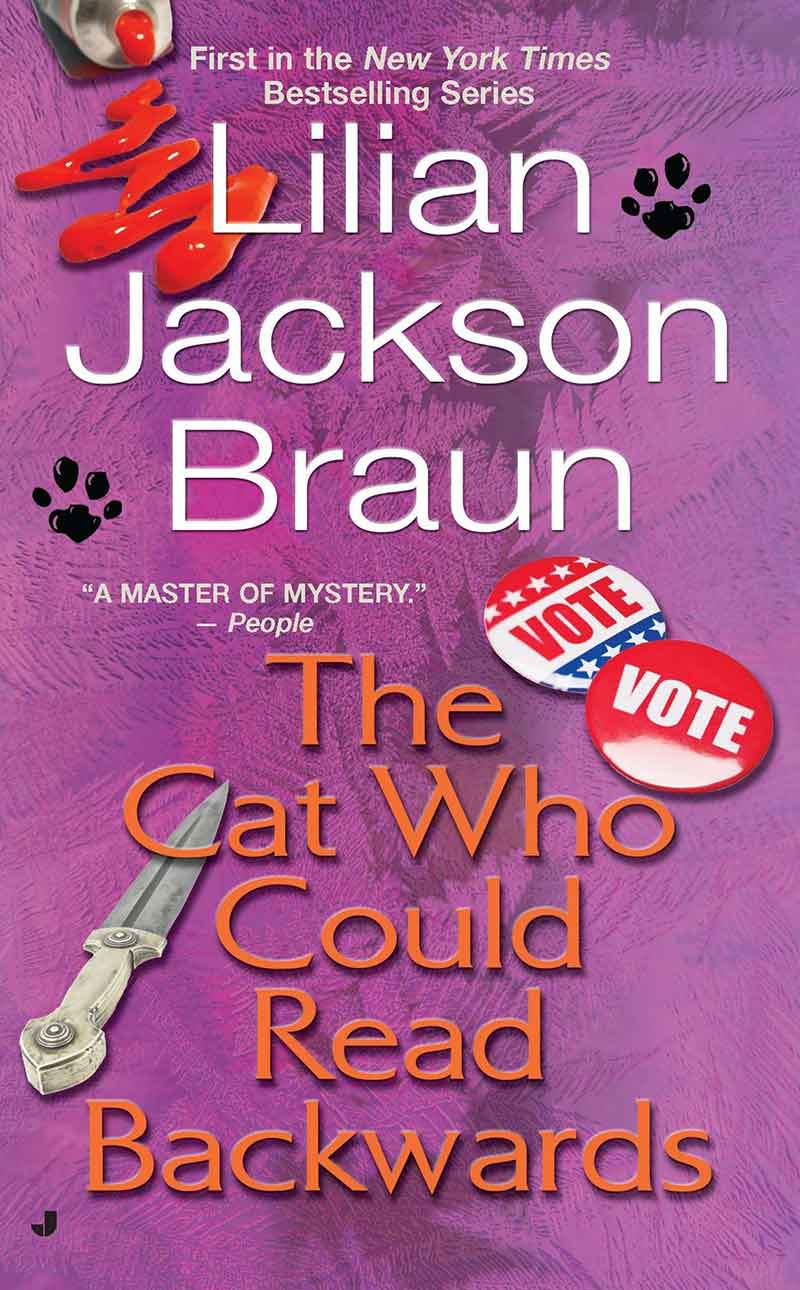Why do we love a feline gumshoe?
Britt Petersen at Slate cites a literary tradition of mystical cats, including “Poe’s ‘Black Cat,’ the demonic Behemoth in Bulgakov’s The Master and Margarita, H.P. Lovecraft’s Cats of Ulthar, and Dr. Seuss’ Cat in the Hat.”
But Jake Hinkson at Criminal Element states the obvious:
Cats…are mysterious little bastards. You have to give them that. They disappear for hours or days at a time. They like the night. (Hell, they have night-vision.) They stare at most humans with the same mix of condescension and malice.
Serendipitously, Lilian Jackson Braun (1913-2011), the most famous creator of a feline detective, is also a late bloomer. She started writing fiction at age 53. Her protagonist is a reporter who regularly stumbles over bodies.
Her hero, however, is a Siamese cat named Koko who intuits clues.
Lilian passed away at age 98 after a second act that lasted close to a half-century and produced a popular 29-book series.
The Cat Who Could Read Backwards and Beyond
Lilian Jackson Braun was born on June 20, 1913, in Willimansett, a tiny Massachusetts village. She began reading and writing at age three, but she turned 16 just as the Depression began, so college was out of the question.
Lilian worked as a copywriter and public-relations executive before signing on as a lifestyle writer at The Detroit Free Press.
She published The Cat Who Could Read Backwards at age 53. The book debuted in 1966 and evokes the golden era of cocktails, abstract art, and daily newspapers.
Jim Qwilleran, the book’s human protagonist, was once a prize-winning investigative journalist until his wife left him and he turned to scotch-on-the-rocks. (It’s unclear which came first.)
Finally sober but sporting a large resume gap, he lands a job covering the art scene in an unnamed town a few hours from New York City:
…he noticed a copyboy feeding yellow pencils into a small moaning contraption. Qwilleran stared at the thing. An electric pencil sharpener! He had never thought it would come to this. It reminded him how long he had been out of touch.
Although Qwill “doesn’t know the Venus de Milo from the Statue of Liberty,” his employer, The Daily Fluxion, seems unconcerned.
They just need some human interest stories to balance the vitriolic fervor of their reclusive art critic, George Bonifield Montclemens III.
With few exceptions, the whole art community loathes Montclemens. But his scathing column attracts a huge number of readers who can’t resist the carnage. As one of Qwilleran’s colleagues puts it:
All the artists in this town hate each other, and all the art-lovers take sides. Then everybody plays rough. It’s like football only dirtier. Name-calling, back-biting, double-crossing—
Montclemens summons Qwilleran to his subdivided Victorian in a once-fashionable neighborhood. Most of the stately homes have become cheap rooming houses or quarters for odd business enterprises.
Qwilleran pegs the mender of antique porcelain as a bookie and the manufacturer of burlesque costumes as, well, take a guess.
But Montclemens proves to be a genteel Noel Coward-type who cooks like a French chef and offers Qwilleran one of his flats on the cheap. Qwilleran, desperate to leave his ratty hotel, accepts without realizing the catch.
Or rather, the cat. Enter our real hero, a Siamese named Kao K’o-Kung after a 13th-century Chinese artist. Koko, as he’s known, loves the smell of fresh ink and reads newspaper headlines from right to left, of course.
When Montclemens visits New York to acquire art, Qwilleran’s job is to feed Koko raw beef warmed in broth with a sprinkle of sage. The bodies don’t pile up until the midpoint, but there’s no shortage of eccentricity in the early pages.
The Cat Who Could Read Backwards proved an instant success. Koko isn’t a silly or supernatural cat who talks. He just does what cats do (like sniffing out a musty hidden staircase or bloody murder weapon) and leaves the rest to Qwilleran.
They make an entertaining team. Lilian considered Koko her Sherlock Holmes and Qwill her Watson.
Lilian wrote two more successful novels in the series, but her publisher rejected the fourth because the market had changed.
“They wanted sex and violence, not kitty-cat stories,” she recalls.
The Story Behind Lilian Jackson Braun’s Long Writing Hiatus
After several more publishers passed on the next novel in her series, Lilian stopped writing. She threw herself into her day job at The Detroit Free Press and climbed the ranks. Sixteen years passed. Her first husband passed away and she retired from the newspaper.
Lilian eventually remarried former actor Earl Bettinger, an old family friend. He encouraged her to resubmit the abandoned manuscript.
In 1986, the Berkley Publishing Group published The Cat Who Saw Red. It was nominated for an Edgar Award, ending Lilian’s quiet retirement.
Lilian produced one or two books a year until 2007. Writing came easy for her “after working from nine to five for fifty years.”
She eschewed rigid hours or word count goals. She preferred to draft in longhand on legal pads, then edit on a typewriter. (Although the method seems arduous now, James Michener wrote the same way.)
When asked how much of her work was inspired by her own cats, Lilian replied
Everything! I don’t believe I could write the books without my cats. Every day they do something that gives me an idea. They are very creative, and what they do starts me off on a new idea…
Lilian Jackson Braun passed in 2011 from a lung infection, just shy of her 98th birthday. She wasn’t able to complete her thirtieth novel, The Cat Who Smelled Smoke.
“She regretted it most of all because so many fans wanted another book,” her husband observed.
It’s sad that Lilian stopped writing for sixteen years because sex and violence became the norm. But I like to think she incubated her time at the newspaper and spun it into her fiction later.
From her debut as a novelist at age 53, beyond rejection and that dry spell, Lilian Jackson Braun “ultimately created a whole new chapter in the American mystery,” her editor at Berkley observed.
If you enjoyed this piece about Lilian, these might also interest you:
Do you have a four-legged muse?
Sources
- The Barnes & Noble Q&A
- Women of Mystery by Martha Hailey Dubose (Thomas Dunne: 2000)
- Opening Image: Photo by Jamie In Bytown on Flickr


